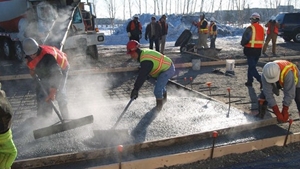.A poured concrete patio is probably one of the more common options many homeowners will choose because of its all around adaptability to most sites. Also, the cost of a poured concrete patio will generally be lower than other available options. Concrete is a difficult material to work with. It has to be poured rather quickly to be able to finish it while it is still in the right state of setting firmness.
I would like to help you get a better understanding of working with this widely available material for your patio projects.
What needs to be prepared ?
In order for a poured concrete patio to be constructed in long-lasting and appealing manner a good base preparation needs to be done. Concrete patios will usually be four inches thick. A good base preparation will add another four inches of thickness to the new patio.
With this in mind, you should excavate the site for your patio to a depth of 8 inches below your desired final top of patio surface height. Excavate beyond the planned edges of the concrete patio by at least six inches.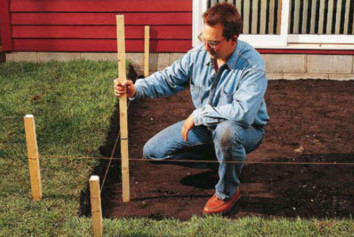
Excavating the site will be the first step in building your new patio. To start off the edges of the patio need to be marked out. This can be accomplished by using stakes and string lines for straight edges. Use marking paint to transfer the lines to the ground.
For curved edges, garden hoses can be used to roughly layout the perimeter lines. Marking out the final position can be done by using spray can marking paint artistically spraying the free flowing lines.
Once your perimeter edges are marked out and final heights have been established the excavation can begin. A properly established final height will run rain water off the patio and away from a nearby home. This is accomplished by gently sloping the concrete top surface in the desired directions.
What is used for base materials ?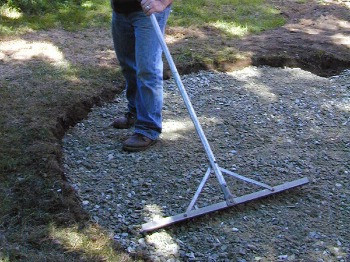
After the excavation is complete, it is time to install the base materials. It is very important for a concrete patio to be installed on a well-prepared base. A completed concrete slab is just one large mass of hard and not very flexible material. It is important that any water that may get under the completed patio can flow freely and be able to flow away.
This will keep the earth beneath the patio from developing soft spots that the concrete may settle into and form cracks. The most common materials used for this concrete base is 3/4 inch crushed stone. This material compacts easily and allows water to readily pass through.
Concrete Forms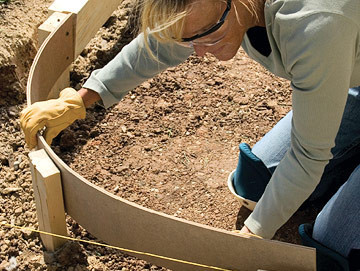
Staked forms define and contain the edges of the concrete patio. A 2×4 will usually work well for this purpose. When the edges curve, a flexible form is needed such as ¼ luan plywood strips.
A plastic or thin metal material can also be used for forming curved edges. The before mentioned sloping patio top is achieved by placing the forms higher and lower in relation to each other to make collecting water flow in the desired direction.
The forms are laid along the planned line of the patio edge. Wood or metal stakes are placed about every 2 or 3 feet along the form and pounded into the ground. The form is raised into its desired final position and screwed to the stakes As a final form securing method some of the excavated earth is placed along the outside face of the form.
Concrete Reinforcement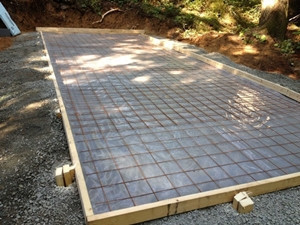
In order to keep a large area of concrete from developing cracks it is necessary to use metal reinforcement and strategically placed control joints. The reinforcement can consist of 6×6 / 10-10 wire fabric placed in all areas of planned concrete placement.
It may also serve well to use #4 rebar in areas that need added help in support from sagging and cracking. Rebar can also be used as dowels to connect the new slab to an existing floor or wall.
The Concrete Pour
Once all the above steps have been completed, it is time to place the concrete. In some areas it may be necessary to contact the building department for an inspection.
Control joints consisting of plastic or some other material will need to be staked into place. Many contractors today place control joints by cutting them into the hardened slab with a diamond blade mounted on a demo-saw.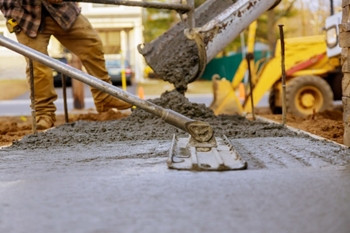
When all is ready, the concrete is ordered. Generally the strength ordered is either 3500 psi or 4000 psi. The Portland cement / aggregate ratios are adjusted to make these various concrete strengths. The psi rating is the point at which the concrete begins to fail under hydraulic pressure.
Your concrete is delivered in a specially designed truck that mixes and discharges the concrete. The amount of water used in mixing the concrete is determined on site. A concrete crew will usually consist of 2 to 3 finishers and 3 to 4 laborers.
Laborers do most of the heavy work in placing the concrete. Finishers work to flatten and tool a final finish on to the hardening concrete. Some crews can make the concrete look like stone or brick surfaces. This is done by applying coloring to the plastic surface. Brick or stone patterns are imprinted into the concrete with specially designed rubber mats.
Obtain a more traditional finish by dragging a broom across the still plastic surface. On the following day the concrete crew will return to cut control joints and remove the concrete forms.
Closing thoughts
As you make plans to install your concrete patio, you can refer to this post to help you understand the processes that are unfolding. Please leave comment below to share your experiences on ongoing or past concrete projects. Thank you for taking a look at this post today and I hope it will help you to better understand the process.
